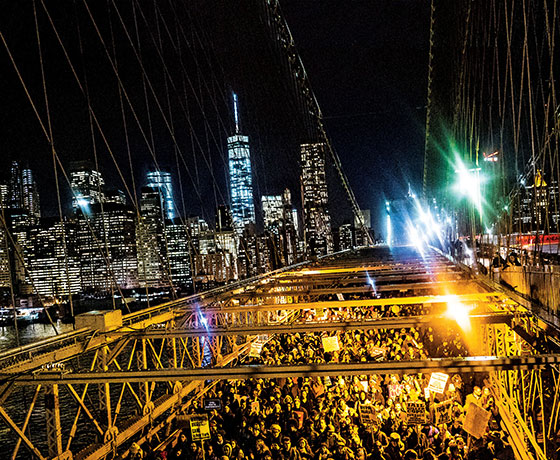 |
Protesters on the Brooklyn Bridge, Thursday, December 4.
(Photo: Benjamin Lowy/Getty Images Reportage) |
“These things tend to peter out on their own,” Police Commissioner Bill Bratton, unfazed after a protester doused him with fake blood, told reporters recently, referring to the rolling demonstrations that moved through the city immediately after a grand jury voted not to indict Officer Daniel Pantaleo for choking Eric Garner to death. “People get tired of marching around aimlessly.”
But Bratton seemed to be thinking of an older version of the city. In Giuliani’s New York, street protest was often a theater of mute frustration. In many other places, it still is. But since the Occupy Wall Street movement three years ago, protest in New York has become not simply a release valve from politics but an extension of politics.
The demonstrations continued. In their second week, there were headlines not just about the theatrics of the City Hall die-ins, or the standstill at the Staten Island Expressway, but about how differently the cops treated the white and black protesters they arrested. The demonstrators were urged on by the mayor himself, as if they were cleanup crews dispatched to scrub the ethical mess. “You’re seeing [change] before your eyes because you already demanded it,” Bill de Blasio told the protesters, referring to liberal reforms to stop-and-frisk and marijuana-arrest policies. “Keep demanding it.”
They did. And in doing so, they are forcing the public discussion about policing and race to catch up to the reality of a New York in which crime is no longer much of a threat and it is the state’s often blithe attitude toward black lives that is the problem.
Over the past few weeks, it’s been easy to think that the police are more callous toward minorities than ever—Frank Serpico appeared in the pages of the Daily News saying exactly that—but a city in which the white mayor can talk movingly about coaching his biracial son to be careful around cops is a different city from Frank Serpico’s. The police in Ferguson, Missouri, greeted protesters with armored hostility. In New York, one of the most powerful images came in Times Square, where a long line of cops linked arms and simply walked through the demonstration, a nonviolent gesture that mirrored the protesters’. You couldn’t say that the city was bending toward justice. It was far too early for that, and justice is far too complicated. But you could say that because of the protests, New Yorkers, even in a very fraught and angry moment, were beginning to bend toward one another.